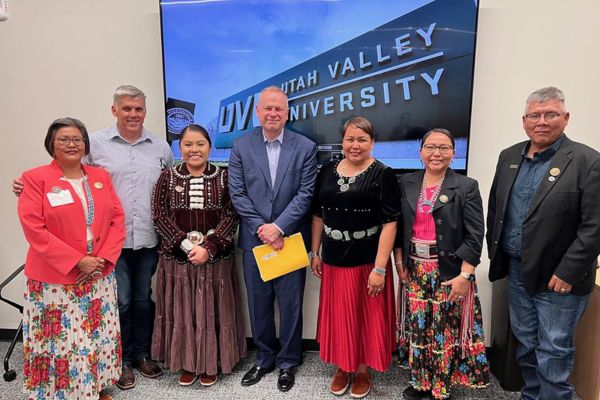
- Details
- By Native News Online Staff
The 25th Navajo Nation Nation Council convened last week during the 17th Annual Governor’s Native American Summit in Orem, Utah, to discuss advancing ongoing efforts to connect two communities in the nation with a paved roadway.
The two communities, Navajo Mountain and Oljato, are located in the western portion of the Navajo Nation and are approximately 30 miles apart. The only paved route to get from one community to another requires residents and other commuters to travel over 100 miles through rough terrain that often involves the use of four-wheel drive vehicles.
The meeting focused on two possible routes that would improve transportation efficiency, drive economic growth and tourism opportunities, improve emergency response time and access to services, and significantly improve the quality of life for many locals.
“Many residents, including elders, commute through these rough roads for long hours each day for basic services and necessities, hauling water for their families and livestock, and going to school and work,” Navajo Nation Council Delegate Herman M. Daniels said in a statement. “If we pave a roadway, it would also increase tourism in the area and create jobs and revenue for the Navajo Nation, the counties, and the entire state of Utah. This project will require significant investments, but it will create additional benefits in the long-term.”
According to a statement from the Navajo Nation Council, emergency response time for the impacted region is anywhere from two hours to three days, depending on the weather and road conditions.
The committee is continuing to gather data on loss of life due to slow emergency response times — with an emphasis on the COVID-19 pandemic — to underscore the need for the paved road.
According to a statement from Navajo Division of Transportation Roads Manager Joe Peterman, the Navajo Nation receives approximately $52 million annually from federal highway funding, with $36 million allocated for road construction for the entire Navajo Nation, which spans more than 27,000 square miles.
Paving the roadway between Navajo Mountain and Oljato could range from approximately $161 million to $186 million, according to a statement from the Navajo Nation Council. At last week’s council meeting, delegates determined that funding needs to be identified for a development plan and environmental impact study.
Council Speaker Crystalyne Curley said securing funds and completing the project will require buy-in from multiple levels of government.
“The Navajo Nation Council will continue working closely with the stakeholders to secure funds and other resources,” Curley said in a statement. “To move the project forward, it will be challenging and will require support and input from many of our county, state, and federal partners.”
More Stories Like This
Native News Weekly (August 25, 2024): D.C. BriefsUS Presidents in Their Own Words Concerning American Indians
Happy Thanksgiving from Native News Online
Coming Up on Native Bidaské: Behind the Animation: Joey Clift Talks “Pow” and Native Storytelling
Two West Virginia Guardsmen Shot Near White House
Help us tell the stories that could save Native languages and food traditions
At a critical moment for Indian Country, Native News Online is embarking on our most ambitious reporting project yet: "Cultivating Culture," a three-year investigation into two forces shaping Native community survival—food sovereignty and language revitalization.
The devastating impact of COVID-19 accelerated the loss of Native elders and with them, irreplaceable cultural knowledge. Yet across tribal communities, innovative leaders are fighting back, reclaiming traditional food systems and breathing new life into Native languages. These aren't just cultural preservation efforts—they're powerful pathways to community health, healing, and resilience.
Our dedicated reporting team will spend three years documenting these stories through on-the-ground reporting in 18 tribal communities, producing over 200 in-depth stories, 18 podcast episodes, and multimedia content that amplifies Indigenous voices. We'll show policymakers, funders, and allies how cultural restoration directly impacts physical and mental wellness while celebrating successful models of sovereignty and self-determination.
This isn't corporate media parachuting into Indian Country for a quick story. This is sustained, relationship-based journalism by Native reporters who understand these communities. It's "Warrior Journalism"—fearless reporting that serves the 5.5 million readers who depend on us for news that mainstream media often ignores.
We need your help right now. While we've secured partial funding, we're still $450,000 short of our three-year budget. Our immediate goal is $25,000 this month to keep this critical work moving forward—funding reporter salaries, travel to remote communities, photography, and the deep reporting these stories deserve.
Every dollar directly supports Indigenous journalists telling Indigenous stories. Whether it's $5 or $50, your contribution ensures these vital narratives of resilience, innovation, and hope don't disappear into silence.
 The stakes couldn't be higher. Native languages are being lost at an alarming rate. Food insecurity plagues many tribal communities. But solutions are emerging, and these stories need to be told.
The stakes couldn't be higher. Native languages are being lost at an alarming rate. Food insecurity plagues many tribal communities. But solutions are emerging, and these stories need to be told.
Support independent Native journalism. Fund the stories that matter.
Levi Rickert (Potawatomi), Editor & Publisher

